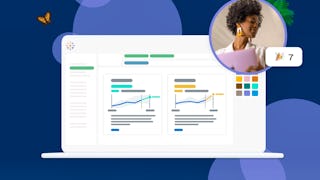The Introduction to Tableau course will give you an understanding of the value of data visualizations. You will learn how to preprocess data and how to combine data from multiple tables found within the same data source as well as other data sources in Tableau Public. You will have developed the skills to leverage data visualization as a powerful tool for making informed decisions.



Introduction to Tableau
This course is part of Tableau Business Intelligence Analyst Professional Certificate

Instructor: Tableau Learning Partner Instructor
30,006 already enrolled
Included with 
(249 reviews)
Recommended experience
What you'll learn
Describe the value of data visualizations in the field of business analytics.
How to preprocess data using Tableau Public
How to combine data from multiple tables found within the same data source as well as other data sources in Tableau Public.
Details to know

Add to your LinkedIn profile
13 assignments
See how employees at top companies are mastering in-demand skills

Build your Data Analysis expertise
- Learn new concepts from industry experts
- Gain a foundational understanding of a subject or tool
- Develop job-relevant skills with hands-on projects
- Earn a shareable career certificate from Tableau Learning Partner


Earn a career certificate
Add this credential to your LinkedIn profile, resume, or CV
Share it on social media and in your performance review

There are 3 modules in this course
Welcome to the first week of the course! This week, you’ll start with a high-level overview of data visualizations. Specifically, you'll learn what they are and what makes them so powerful and — as a result — why they are such a vital asset when it comes to not only discovering insights but also communicating those insights with stakeholders. The focus will then shift to Tableau, one of the most popular data visualization tools in the analytics industry. In this module, you’ll get signed up with a Tableau Public account and then dive right in by connecting to a data source and exploring the different components of Tableau.
What's included
5 videos20 readings4 assignments1 discussion prompt
As an analyst, data preparation is the most important step for impactful analysis. Without clean data, you can lead an audience to incorrect conclusions, which can ultimately undermine your credibility and even potentially cause harm. Data cleaning is not a perfect process — a good motto for all analysts is "Question everything!" (Especially your data.) Data preparation is also an iterative process. You start by wrangling dirty data but then move on to smaller, more intentional data preparation — usually to finalize your analysis or prepare your data for an audience. Preparing data in Tableau requires a different, more design-oriented level of scrutiny when compared with file or database cleaning to finalize the data for presentation purposes. This module will teach you concepts that must be implemented in a professional environment, especially if a data visualization is intended for presentation. Remember, without clean, well-prepared data, data visualizations can point to incorrect conclusions.
What's included
9 videos16 readings4 assignments
As the amount of data in the world exponentially grows, the need for combining data sources becomes ever more critical. Understanding how to combine data sources opens whole new areas of study. As an analyst, your daily tasks will often include combining various data sources in search of new insightful visualizations. When it comes to connecting data sources in Tableau, the amount of data you are connecting can affect the performance of your data visualizations. Because of this, Tableau offers multiple ways to combine data that help analysts optimize workflow and create more efficient data visuals.
What's included
7 videos19 readings5 assignments1 discussion prompt
Instructor

Offered by
Recommended if you're interested in Data Analysis


SkillUp EdTech


Tableau Learning Partner


Corporate Finance Institute


Tableau Learning Partner
Why people choose Coursera for their career




Learner reviews
249 reviews
- 5 stars
86.34%
- 4 stars
10.84%
- 3 stars
0.80%
- 2 stars
0.40%
- 1 star
1.60%
Showing 3 of 249
Reviewed on Dec 7, 2024
Great course! I enjoyed the final project. I am slowly but surely starting to feel more confident with the tool.
Reviewed on Mar 25, 2024
Kudos to Shaun and PathStream for making learning practical and also insightful for the future. Thank you!
Reviewed on Jan 22, 2024
The best course that teach the very first steps to Tableau in detail
New to Data Analysis? Start here.

Open new doors with Coursera Plus
Unlimited access to 10,000+ world-class courses, hands-on projects, and job-ready certificate programs - all included in your subscription
Advance your career with an online degree
Earn a degree from world-class universities - 100% online
Join over 3,400 global companies that choose Coursera for Business
Upskill your employees to excel in the digital economy
Frequently asked questions
Access to lectures and assignments depends on your type of enrollment. If you take a course in audit mode, you will be able to see most course materials for free. To access graded assignments and to earn a Certificate, you will need to purchase the Certificate experience, during or after your audit. If you don't see the audit option:
The course may not offer an audit option. You can try a Free Trial instead, or apply for Financial Aid.
The course may offer 'Full Course, No Certificate' instead. This option lets you see all course materials, submit required assessments, and get a final grade. This also means that you will not be able to purchase a Certificate experience.
When you enroll in the course, you get access to all of the courses in the Certificate, and you earn a certificate when you complete the work. Your electronic Certificate will be added to your Accomplishments page - from there, you can print your Certificate or add it to your LinkedIn profile. If you only want to read and view the course content, you can audit the course for free.
If you subscribed, you get a 7-day free trial during which you can cancel at no penalty. After that, we don’t give refunds, but you can cancel your subscription at any time. See our full refund policy.
More questions
Financial aid available,

